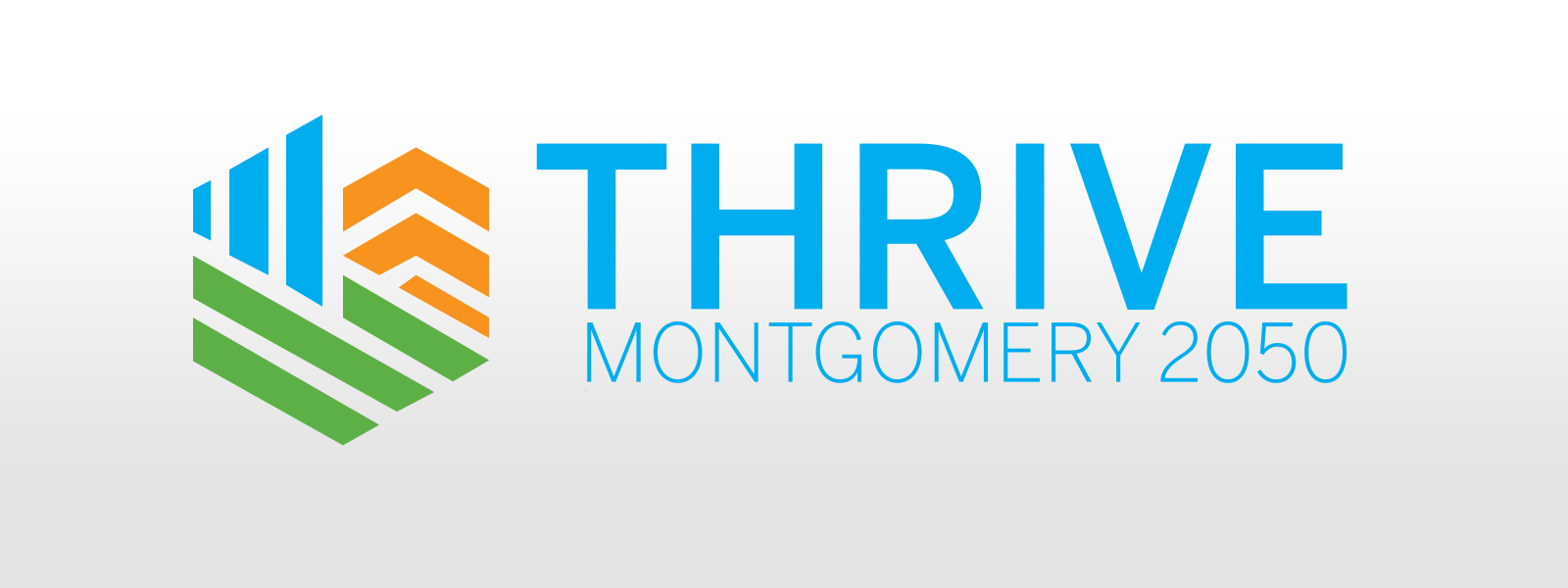What will Montgomery County be like in 2050? The Meeting-in-a-box kit is a tool designed for use by civic and neighborhood associations, community groups or friends to gather and share their ideas for the future of Montgomery County, ideas that will help to inform and shape the Thrive Montgomery 2050 plan. The Meeting-in-a-box kit contains everything you need to host a discussion about the future of Montgomery County.
Instructions
Host Guide
Download the Meeting-in-a-Box Complete the Worksheet Online
If you are a host completing the Meeting-in-a-box online, please make sure you have a good connection to the internet. If you are completing the Meeting-in-a-box individually, you may skip ahead to the worksheet.
Roles
Defining roles can help create an interactive environment for everyone to participate throughout the meeting. Attendees need to assume three main roles in order to help keep your meeting running smoothly:
- Host (1) – Responsible for printing out materials (if the meeting is offline), facilitating the meeting, completing the Host Feedback Form, collecting all materials and returning materials to Montgomery Planning staff.
- Note-taker (at least 1) – Responsible for writing down notes from the discussion on the Group Priority Worksheet. If you break into smaller groups, you will need a note-taker for each group.
- Participants (everyone) – Responsible for engaging in the exercises.
Instructions for Meeting Hosts
Purpose of the Meeting
- Introduce the community to Thrive Montgomery 2050, Montgomery County’s General Plan update.
- Solicit community input on priorities and topics that will be addressed in the Thrive Montgomery 2050 plan.
Time Needed
1 hour for the meeting, plus time to plan and prepare.
Materials Needed (if completing offline)
- One copy of the Meeting-in-a-Box packet.
- Pens for participants.
Conducting Your Meeting
Invite your friends, neighbors, colleagues or others to your meeting (Host).
- Identify and invite participants to your meeting. Around 8-12 is a good number to facilitate a meaningful small group discussion, but you may want to invite a few more, assuming not all will be able to attend. It’s okay if you have fewer and you can invite more if you are comfortable facilitating a larger group.
- Send your meeting invitation via email, mail or call participants on the phone to welcome them to your meeting (see Sample Invitation). Be sure to allow enough time for people to schedule and try to find a time of day that works for everyone.
- Be sure to remind your participants one to two days before the scheduled meeting to confirm participation of your group.
Prepare materials (Host)
- Print enough copies of the Group Priority Worksheet for all of the participants. Collect pens and pencils for participants.
Facilitate a meeting (Host, Notetaker, Participants)
Introduction (10 minutes)
- Take a few minutes at the beginning of the meeting for introductions. Then, introduce Thrive Montgomery 2050 to the group, using the Introduction to Thrive Montgomery 2050 talking points on page 5.
- As a group, watch the Introduction to Thrive Montgomery 2050 video.
- Pass around the Email List for individuals who are interested in receiving emails about Thrive Montgomery 2050 and keeping up-to-date about the plan. Individuals can also sign up online.
Group Discussion (1 hour)
- Form groups to have a discussion. These meetings are designed to encourage active group conversations. If you are hosting a large meeting with more than 12 people, we suggest that you break into small groups and make sure each group has a note taker and a facilitator.
- In each group, begin going through the Group Priority Worksheet. Determine top 3 priorities and policy ideas for each topic.
Conclusion (5 minutes)
- Thank participants for their participation in the discussion and remind them to sign-up for emails on the Email List.
- Remind them to visit www.thrivemontgomery.com to complete the Thrive Quiz and learn more about Thrive Montgomery 2050.
- Encourage each participant to host a Meeting-in-a-Box of their own.
Submitting Materials
Collect all of the Participant Worksheets and the Email List. Complete the Meeting Summary and Host Feedback Form. Return the materials to Montgomery Planning by February 1, 2020:
- Method 1: Type your results online.
- Method 1: Scan and email materials to thrive2050@montgomeryplanning.org
- Method 2: Mail or drop off at: Attention: Thrive Montgomery 2050
Montgomery Planning
c/o Research and Special Projects
8787 Georgia Ave
Silver Spring MD 20910
Montgomery Planning is grateful for your time, thoughts, ideas and participation to inform Thrive Montgomery 2050. Your participation is part of a collaborative effort in shaping a thriving Montgomery County.
How is Montgomery County Changing?
Over the past 50 years, Montgomery County has experienced a host of changes:
- Technology is changing. The widespread use of digital technologies has changed how we work, shop, learn, communicate and interact.
- Montgomery County is more diverse. People of color now make up about 56 percent of the population, compared with 28 percent in 1990, according to the 2019 Montgomery County Trends Report. Today, 33 percent of residents are foreign-born, compared to 19 percent in 1990. And residents have grown older: About 16 percent are 65 or older and by 2040, this age group is expected to increase to 20 percent of the population.
- Montgomery County is a major employment center. We’ve grown from a bedroom community of residents mainly commuting to work outside of the county to a major employment center where 60 percent of people who live in the county also work here. Most of our workers are in education, health care, hospitality or food service, professional services, and life sciences. Just 15 percent of the county’s workers are employed by the federal government.
- Home values are high. Single-family homes cost 40 percent more than they did 20 years ago and rents are nearly 50 percent higher than they were in 2000, making housing affordability a big issue. Over the same time, incomes have been fairly stagnant and are not keeping pace with the increase in housing prices.
- Where, when and how people work are changing. Office space vacancies are higher than they’ve been in more than a decade. More people are telecommuting and coworking. Companies with offices are choosing downtowns near public transit rather than suburban office parks and reducing space per employee.
- The climate is changing. Threats from extreme weather events, such as dangerous heat and flooding storms are increasing. Impacts include harm to human health, economic losses and environmental degredation.




